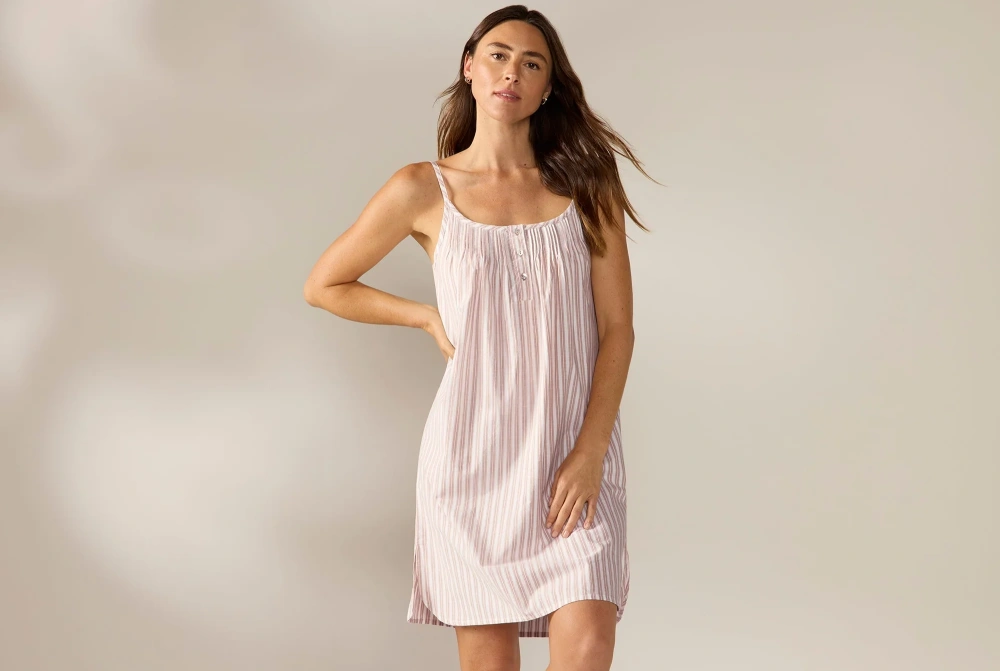When considering what to wear under a nightgown for both hygiene and comfort, you have a variety of options. Many women choose to wear underwear, a soft bra, shorts, a camisole, or sometimes opt to wear nothing at all under their nightgown.
The answer to what to wear under a nightgown depends on your comfort, as well as your preferences for hygiene and fabric. Some people select underwear or other garments for modesty, extra coverage, or simply to feel more at ease.
Others find that wearing nothing under a nightgown feels more natural and comfortable. For those seeking premium comfort, Friendtex offers sleepwear crafted from high-quality, breathable fabrics, ensuring you enjoy a restful night’s sleep no matter what you choose to wear under your nightgown.
Key Takeaways
Choose breathable, natural fabrics like cotton or bamboo to keep your skin cool, dry, and comfortable under your nightgown.
Wearing underwear under a nightgown is a personal choice; pick soft, well-fitting styles to avoid irritation and support hygiene.
Sleeping without underwear can improve airflow and reduce skin irritation if you wear clean, breathable nightgowns.
Always wash your sleepwear regularly and shower before bed to maintain hygiene and freshness.
Focus on what feels best for you, balancing comfort, hygiene, and personal style for a restful night’s sleep.
What Do You Wear Under a Nightgown?
When you ask yourself what you wear under a nightgown, you might be surprised by how many options you have. Some people prefer classic undergarments, while others feel best with nothing at all. Your choice depends on your comfort, hygiene needs, and even your mood that night.
Let’s break down the most common choices and what makes each one work for different people.
Underwear Choices
If you like a little extra coverage or support, wearing underwear under your nightgown is a popular choice. You might reach for briefs, bikinis, boyshorts, or hipsters. Each style offers a different fit and level of coverage. Here’s a quick look at some common types:
Underwear Type | Coverage & Fit | Fabric & Comfort Features |
|---|---|---|
Briefs | Full coverage, high waist; smooth outline under clothes | Available in cotton, silk, and moisture-wicking fabrics; good for comfort and hygiene |
Bikini | Moderate coverage, sits low on the hips | Variety of fabrics; balance of comfort and style |
Boyshorts | Full hip coverage, sporty look; extends to thighs | Made from cotton or flexible blends; comfortable and breathable |
Hipsters | Mid-coverage, sits low on the hips | Often seamless, available in cotton and lace; comfortable fit |
You want to pick undergarments made from breathable, natural fabrics like cotton or micromodal. These materials help wick away moisture and keep your skin dry, which is important for preventing irritation and infections.
Cotton is a favorite for many women because it feels soft and lets your skin breathe. If you have sensitive skin or just want to stay cool, natural fibers are your best bet.
Some people also like to wear a soft bra, especially if they want a bit of support while sleeping. Others choose underpants or even lightweight shorts for extra coverage. The key is to avoid anything too tight or made from synthetic fabrics that trap heat and moisture.
Tight underwear can cause discomfort, restrict circulation, and even lead to skin issues like chafing or rashes. Loose, well-fitting undergarments keep you comfortable and help you sleep better.
If you care about the environment, you might want to look for underwear made from organic cotton, bamboo, or Tencel. These fabrics are not only gentle on your skin but also have a smaller environmental footprint.
Friendtex offers a range of premium sleepwear and undergarments crafted from these sustainable materials, so you can feel good about your choice in more ways than one.
Tip: Always wash your underwear and sleepwear regularly. Clean fabrics help prevent irritation and keep you feeling fresh.
Sleeping Without Underwear

You might wonder if sleeping without underwear under your nightgown is a good idea. Many people find this option incredibly comfortable. It lets your skin breathe and can help keep your intimate areas cool and dry.
Medical professionals often recommend sleeping without underwear or choosing loose, breathable clothing for optimal hygiene. This practice can lower your risk of yeast infections and other skin irritations by improving airflow and reducing moisture buildup.
Here’s a quick table to help you weigh the benefits and drawbacks:
Potential Hygiene Benefits | Potential Hygiene Drawbacks |
|---|---|
Improved air circulation reduces the risk of yeast infections and bacterial vaginosis | Risk of bedding staining during menstruation or unexpected discharges |
Better temperature regulation promotes comfort and may prevent overheating | Potential irritation for sensitive skin from direct contact with bedding |
Decreased skin irritation due to less friction | Increased susceptibility to minor injuries or scratches in intimate areas without underwear protection |
Enhanced sleep quality through unrestricted movement and comfort | Possible increased exposure to microorganisms if there are open cuts or abrasions |
Hygiene considerations are important when sharing a bed with a partner | Discomfort from sweating and lack of protection from bodily fluids |
If you decide to go commando, make sure your nightgown is made from a soft, breathable fabric.
This helps prevent irritation and keeps you comfortable all night. Friendtex sleepwear uses high-quality, natural materials that feel gentle against your skin and support healthy airflow.
Some people worry that not wearing undergarments at night is unhygienic, but that’s not always true. The real key is choosing the right fabric and keeping your sleepwear clean.
Breathable, organic cotton or bamboo nightgowns can help regulate your body temperature and wick away moisture, making sleeping without underwear a healthy and comfortable option.
Cultural norms and personal habits also play a role in what you wear under a nightgown. In some cultures, modesty or tradition might encourage you to wear underpants or other undergarments, while in others, sleeping without underwear is completely normal. No matter what you choose, focus on what feels best for you.
So, what do you wear under a nightgown? Whether you pick underwear, shorts, a camisole, or nothing at all, the most important thing is your comfort and hygiene. Friendtex offers a variety of premium options to help you find your perfect sleepwear solution.
Wear Underwear to Sleep
Choosing whether to wear underwear to sleep is a personal decision, but it helps to know the facts about comfort and hygiene. You might feel more secure with undergarments, or you may prefer the freedom of going without. Let’s look at what matters when you make this choice.
Fabric Matters
The type of underwear you pick can make a big difference in how you sleep. Breathable fabrics like cotton and bamboo help keep you cool and dry. Cotton is a classic choice because it absorbs moisture and lets your skin breathe, which can help prevent yeast infections and irritation.
Bamboo goes a step further, offering even better airflow and moisture control. It absorbs sweat quickly and dries fast, so you stay comfortable all night. Synthetic fabrics, like polyester or nylon, often trap heat and moisture, which can lead to discomfort or even skin problems.
Here are some key points to consider when picking underwear for sleep:
Cotton and bamboo are gentle on sensitive skin and help reduce the risk of irritation.
Bamboo is naturally hypoallergenic and resists dust mites and mold.
Synthetic fabrics may cause sweating and can irritate your skin.
Wool sleepwear can help you fall asleep faster in cooler rooms, while cotton works well in warmer temperatures.
Tip: Always choose underwear that fits well and feels soft against your skin. Tight or rough fabrics can cause chafing and disrupt your sleep.
Friendtex Sleepwear

If you want the best in comfort and hygiene, Friendtex sleepwear stands out. Friendtex uses lightweight, breathable fabrics that feel smooth and soft.
Their underwear and pajamas wick away moisture, keeping your skin dry and fresh. The seamless design means you won’t have to worry about chafing or irritation. You can even customize your sleepwear for the perfect fit and style.
Customers love how Friendtex pajamas stay soft and vibrant after many washes. Parents say the organic cotton and bamboo fabrics help their kids sleep better, especially if they have sensitive skin. The hypoallergenic materials resist dust mites and mold, making them a smart choice for anyone who values hygiene.
Here’s a quick look at the pros and cons of wearing underwear to bed:
Factor | Pros | Cons |
|---|---|---|
Comfort | Prevents chafing, adds security | Tight underwear can cause discomfort |
Hygiene | Manages sweat, reduces bacterial growth | Dirty underwear can cause irritation |
Fabric Choice | Breathable fabrics keep you cool and dry | Non-breathable fabrics trap moisture |
Support | Offers support where needed | A tight fit may restrict circulation |
When you wear underwear to sleep, focus on clean, breathable fabrics and a comfortable fit. Friendtex makes it easy to find undergarments that support both your comfort and your health.
What Do You Wear to Bed?

When you think about what you wear to bed, you probably picture your favorite pajamas or maybe a comfy old T-shirt. The truth is, there’s no single answer.
People around the world choose all kinds of clothing items worn to bed, from classic pajama sets to shorts, camisoles, or even nothing at all. Your choice depends on what feels best for you, your climate, and your style.
Personal Comfort
Your comfort should always come first. Some people love the feeling of soft cotton pajamas, while others prefer silk or bamboo for their smooth texture and breathability. You might like loose-fitting shorts, a sleep bra, or a cozy nightgown. Women often choose styles that match their mood or the season.
The fit matters, too. Pajamas that are too tight can make you toss and turn, while ones that are too loose might bunch up and feel awkward. Natural fabrics like cotton, bamboo, and silk help your skin breathe and keep you cool or warm as needed.
If you have sensitive skin, look for hypoallergenic materials. Taking a shower before bed and wearing clean sleepwear can also boost your comfort and help you relax.
Tip: Choose sleepwear that feels good against your skin and fits just right. This helps you fall asleep faster and wake up feeling refreshed.
Climate and Style
The weather outside plays a big role in your sleepwear choices. In hot climates, lightweight fabrics like cotton, bamboo, or linen keep you cool and dry. For chilly nights, flannel, fleece, or thermal cotton traps warmth and makes you feel cozy.
Some people layer up with pajama bottoms and a long-sleeve top, while others stick to a simple camisole or shorts. Around the world, you’ll see different styles—silk pajamas in Asia, flannel sets in colder countries, and even traditional robes like the Japanese jinbei.
Friendtex makes it easy to find the perfect match for your needs. You can customize your sleepwear by picking the fabric, color, and fit that suit your style and climate. Friendtex uses sustainable materials like organic cotton, bamboo, and hemp, so you get comfort, style, and peace of mind.
Sleepwear Style | Best For | Fabric Options | Friendtex Customization |
|---|---|---|---|
Pajama Sets | All seasons | Cotton, bamboo, flannel | Yes |
Shorts & Camisoles | Warm climates | Cotton, bamboo, silk | Yes |
Nightgowns | Year-round | Cotton, silk, linen | Yes |
Pajama Bottoms | Cooler nights | Flannel, fleece, thermal | Yes |
No matter your preference, you have plenty of options to create your ideal bedtime routine.
Conclusion
Choosing what you wear under a nightgown comes down to a few simple steps for hygiene and comfort:
Wash your nightgown and sleepwear regularly using gentle methods.
Pick natural, breathable fabrics like bamboo or cotton to keep cool and dry.
Shower before bed to help your sleepwear stay fresh.
Remember, your comfort matters most. Whether you prefer pajamas, underwear, or nothing at all, Friendtex offers premium options to suit your style. Trust your own preferences and enjoy a restful night’s sleep.
FAQ
What is the best fabric to wear under a nightgown?
You want breathable fabrics like cotton, bamboo, or modal. These keep you cool and help prevent irritation. Friendtex sleepwear uses these materials for extra comfort and hygiene.
Should you wear underwear under your nightgown every night?
You don’t have to wear underwear every night. Some people feel more comfortable with it, while others prefer going commando. Try both and see what helps you sleep best.
Can you wear a bra under a nightgown?
Yes, you can wear a soft sleep bra if you want support. Look for bras made from gentle, stretchy fabrics. Avoid anything with wires or tight bands for better comfort.
Is sleeping without underwear hygienic?
Sleeping without underwear can be hygienic if you wear clean, breathable nightgowns. This lets your skin breathe and may lower your risk of irritation. Just make sure you wash your sleepwear often.
How do you keep your nightgown fresh and clean?
Wash your nightgown regularly with mild detergent. Shower before bed to keep your skin clean. Choose natural fabrics that resist odors and feel soft against your skin.


